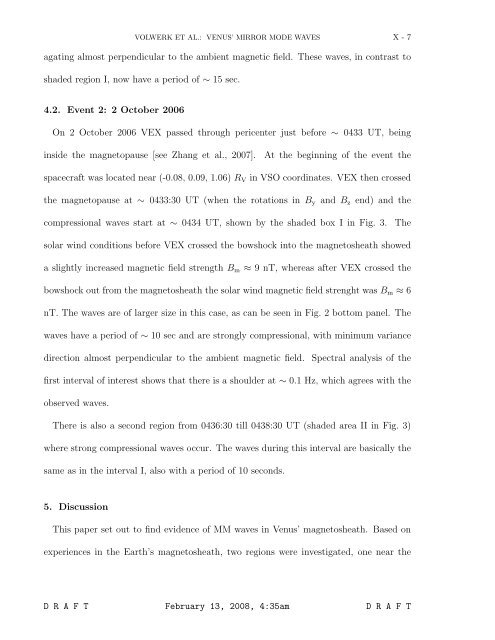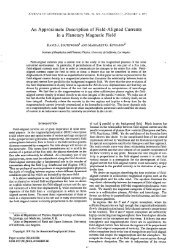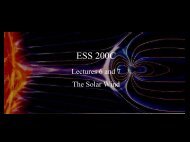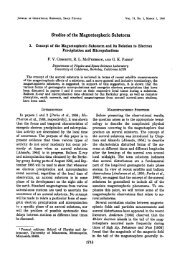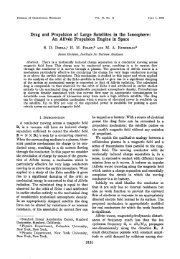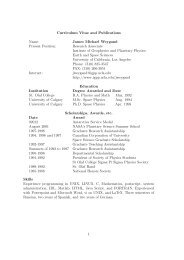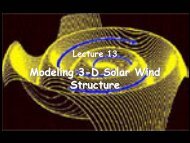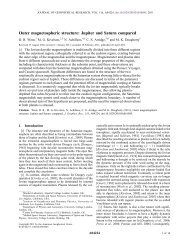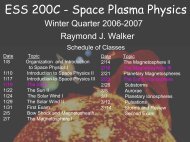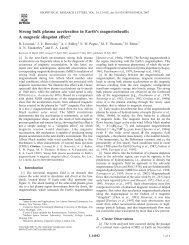First identification of mirror mode waves in Venus' magnetosheath?
First identification of mirror mode waves in Venus' magnetosheath?
First identification of mirror mode waves in Venus' magnetosheath?
Create successful ePaper yourself
Turn your PDF publications into a flip-book with our unique Google optimized e-Paper software.
VOLWERK ET AL.: VENUS’ MIRROR MODE WAVES X - 7agat<strong>in</strong>g almost perpendicular to the ambient magnetic field. These <strong>waves</strong>, <strong>in</strong> contrast toshaded region I, now have a period <strong>of</strong> ∼ 15 sec.4.2. Event 2: 2 October 2006On 2 October 2006 VEX passed through pericenter just before ∼ 0433 UT, be<strong>in</strong>g<strong>in</strong>side the magnetopause [see Zhang et al., 2007].At the beg<strong>in</strong>n<strong>in</strong>g <strong>of</strong> the event thespacecraft was located near (-0.08, 0.09, 1.06) R V <strong>in</strong> VSO coord<strong>in</strong>ates. VEX then crossedthe magnetopause at ∼ 0433:30 UT (when the rotations <strong>in</strong> B y and B z end) and thecompressional <strong>waves</strong> start at ∼ 0434 UT, shown by the shaded box I <strong>in</strong> Fig. 3.Thesolar w<strong>in</strong>d conditions before VEX crossed the bowshock <strong>in</strong>to the <strong>magnetosheath</strong> showeda slightly <strong>in</strong>creased magnetic field strength B m ≈ 9 nT, whereas after VEX crossed thebowshock out from the <strong>magnetosheath</strong> the solar w<strong>in</strong>d magnetic field strenght was B m ≈ 6nT. The <strong>waves</strong> are <strong>of</strong> larger size <strong>in</strong> this case, as can be seen <strong>in</strong> Fig. 2 bottom panel. The<strong>waves</strong> have a period <strong>of</strong> ∼ 10 sec and are strongly compressional, with m<strong>in</strong>imum variancedirection almost perpendicular to the ambient magnetic field. Spectral analysis <strong>of</strong> thefirst <strong>in</strong>terval <strong>of</strong> <strong>in</strong>terest shows that there is a shoulder at ∼ 0.1 Hz, which agrees with theobserved <strong>waves</strong>.There is also a second region from 0436:30 till 0438:30 UT (shaded area II <strong>in</strong> Fig. 3)where strong compressional <strong>waves</strong> occur. The <strong>waves</strong> dur<strong>in</strong>g this <strong>in</strong>terval are basically thesame as <strong>in</strong> the <strong>in</strong>terval I, also with a period <strong>of</strong> 10 seconds.5. DiscussionThis paper set out to f<strong>in</strong>d evidence <strong>of</strong> MM <strong>waves</strong> <strong>in</strong> Venus’ <strong>magnetosheath</strong>. Based onexperiences <strong>in</strong> the Earth’s <strong>magnetosheath</strong>, two regions were <strong>in</strong>vestigated, one near theD R A F T February 13, 2008, 4:35am D R A F T


